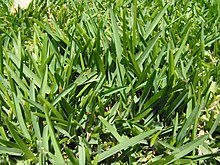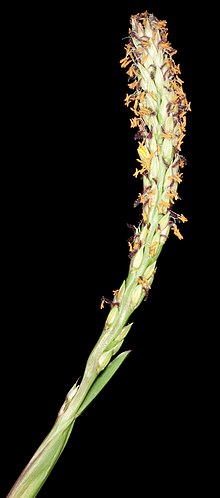How To Keep St. Augustine Green In Winter In Southern California
| St. Augustine grass | |
|---|---|
 | |
 | |
| Scientific classification | |
| Kingdom: | Plantae |
| Clade: | Tracheophytes |
| Clade: | Angiosperms |
| Clade: | Monocots |
| Clade: | Commelinids |
| Order: | Poales |
| Family unit: | Poaceae |
| Subfamily: | Panicoideae |
| Genus: | Stenotaphrum |
| Species: | S. secundatum |
| Binomial name | |
| Stenotaphrum secundatum (Walt.) Kuntze | |
St. Augustine grass (Stenotaphrum secundatum), also known as buffalo turf in Australia and buffalo grass in South Africa, is a warm-season lawn grass that is popular for cultivation in tropical and subtropical regions. It is a medium- to high-maintenance grass that forms a thick, carpetlike sod, crowding out about weeds and other grasses.
Characteristics [edit]

St. Augustine is a dark green grass with wide, flat blades. It spreads by aboveground stolons, unremarkably known every bit "runners", and forms a dense layer.
The grass occurs on both sides of the Atlantic Bounding main,[1] including much of the southeastern The states, Texas,[two] [3] Mexico, and Key and South America.[1] It has escaped cultivation in California,[iv] Hawaii, many Pacific islands, South Africa and New Zealand.[1] [5]
St. Augustine grass occurs in most Caribbean and Mediterranean areas. Information technology grows all-time in tropical climates. It is often seen in lagoons and marshes, on shorelines, and wherever there is a practiced amount of moisture.
Planting and propagation [edit]
Simply recently has commercially valuable and feasible seed for St. Augustine get bachelor, so it has typically been propagated by plugs, sprigs, or sod. In one case the grass is cultivated, it can propagate on its own.
St. Augustine can abound in a wide range of soil types with a pH between 5.0 and viii.5. It commonly blooms in leap and summertime.
Uses [edit]
St. Augustine grass is commonly used in pastures and on ranches. It is a popular backyard grass, rivalling bermudagrass, though St. Augustine is somewhat less drought-tolerant.
Cultivars [edit]
A number of cultivars take been developed:[6]
- 'Captiva' - released in 2007. Adult past the University of Florida for its resistance to the southern chinch issues[7] and its dwarf profile, which requires less mowing.
- 'Floratam' - released in 1973. Developed during an bookish collaboration between the University of Florida and Texas A&G Academy.[8] Resists the viral infection St. Augustine decline (SAD). Non as cold- or shade-tolerant.
- 'Floratine' - released in 1959. Has a darker colour and finer texture. Tolerates lower temperatures and needs less mowing.
- 'Palmetto' - released in the mid-1990s. A smaller, lighter dark-green grass.
- 'Raleigh' - released in 1980. Tolerant of cold, but susceptible to insects and disease.
- 'Sapphire' - released in 2004. Selected from Australia for its dark blue-greenish leaves and purple stolons and rapid lateral growth.
- 'Seville' - released in 1980. Similar to 'Floratam', but with a finer texture.
- 'Sir Walter' - released in 1996. Developed for Australian conditions with traits such as heat and drought tolerance.[nine]
- 'Texas Mutual' - Most similar to the natural species, information technology has fallen out of favor due to its susceptibility to the incurable Deplorable virus.
- 'Variegatum' - in 1993 information technology's given the prestigious Award of Garden Merit by the Royal Horticulture Society . It is a creeping evergreen grass with stripped white leaves
References [edit]
- ^ a b c "Stenotaphrum secundatum (Walter) Kuntze". Pacific Island Ecosystems at Risk (PIER).
- ^ "St. Augustine grass". Center for Aquatic and Invasive Plants. Archived from the original on 2009-01-22.
- ^ "Stenotaphrum secundatum (Walter) Kuntze". USDA PLANTS.
- ^ "Taxon Study 7783: Stenotaphrum secundatum". The CalFlora Database.
- ^ Stenotaphrum secundatum (buffalo grass)
- ^ Trenholm, 50. E., et al. St. Augustinegrass for Florida Lawns. Publication #ENH5. University of Florida IFAS. 1991. Revised 2022.
- ^ Buss, E. A. "Southern Chinch Bug Management on St. Augustinegrass". Publication #ENY-325. Academy of Florida IFAS. 1993. Revised 2022.
- ^ Collaboration Between Texas A&M And University Of Florida Creates Popular Lawn Grass - Texas A&1000 Today
- ^ History of Sir Walter
[1]
External links [edit]
- USDA Plants Profile
- St. Augustine Grass Texas A&Thousand AgriLife Extension.
- Information about St. Augustine grass Cultivars. Clemson Academy Cooperative Extension.
- ^ Stenotaphrum secundatum 'Variegatum' (v) | variegated buffalo grass Conservatory Greenhouse/RHS Gardening
Source: https://en.wikipedia.org/wiki/St._Augustine_grass
Posted by: charlesmistabou.blogspot.com


0 Response to "How To Keep St. Augustine Green In Winter In Southern California"
Post a Comment